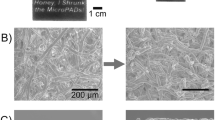Abstract
Two-dimensional paper networks (2DPNs) hold great potential for transcending the capabilities and performance of today’s paper-based analytical devices. Specifically, 2DPNs enable sophisticated multi-step chemical processing sequences for sample pretreatment and analysis at a cost and ease-of-use that make them appropriate for use in settings with low resources. A quantitative understanding of flow in paper networks is essential to realize the potential of these networks. In this report, we provide a framework for understanding flow in simple 2DPNs using experiments, analytical expressions, and computational simulations.





Similar content being viewed by others
Notes
Though nitrocellulose is not formed in the manner traditionally used for papermaking, and may not be considered by some to be a true paper, here we use a more inclusive definition of paper with respect to 2DPNs that includes related thin porous materials.
Note that electrophoresis was not an issue with respect to transport of the pulse of tracer species due to the upstream placement of both electrodes.
References
Alava M, Niskanen K (2006) The physics of paper. Rep Prog Phys 69(3):669–723
Auriault J, Borne L et al (1985) Dynamics of porous saturated media, checking of the generalized law of Darcy. J Acoust Soc Am 77(5):1641–1650
Cabrera C, Finlayson B et al (2001) Formation of natural pH gradients in a microfluidic device under flow conditions: model and experimental validation. Anal Chem 73:658–666
Darcy H (1856) Les Fontaines Publiques de la Ville de Dijon. V. Dalmont, Paris
Fenton E, Mascarenas M et al (2009) Multiplex lateral-flow test strips fabricated by two-dimensional shaping. Appl Mater Interfaces 1(1):124–129
Fu E, Lutz B et al (2010) Controlled reagent transport in disposable 2D paper networks. Lab Chip 10:918–920
Fujita H (1952) On the distribution of liquid ascending in a filter paper. J Phys Chem 56(5):625–629
Holde KEV (1985) Physical biochemistry. Englewood Cliffs, Prentice Hall
Jackson G, James D (1986) The permeability of fibrous porous materials. Can J Chem Eng 64:364–374
Martinez AW, Phillips ST et al (2007) Patterned paper as a platform for inexpensive, low-volume, portable bioassays. Angewandte Chemie (International Edition) 46(8):1318–1320
Martinez AW, Phillips ST et al (2008a) Three-dimensional microfluidic devices fabricated in layered paper and tape. Proc Natl Acad Sci USA 105(50):19606–19611
Martinez AW, Phillips ST et al (2008b) FLASH: a rapid method for prototyping paper-based microfluidic devices. Lab Chip 8(12):2146–2150
Martinez AW, Phillips ST et al (2010) Diagnostics for the developing world: microfluidic paper-based analytical devices. Anal Chem 82(1):3–10
Medina A, Perez-Rosales C et al (2001) Imbibition in pieces of paper with different shapes. Revista Mexicana De Fisica 47(6):537–541
Mendez S, Fenton EM et al (2010) Imbibition in porous membranes of complex shape: quasi-stationary flow in thin rectangular segments. Langmuir 26(2):1380–1385
Nordbotten JM, Celia MA et al (2007) Interpretation of macroscale variables in Darcy’s law. Water Resour Res 43:W08430.1–W08430.9
Peek RL, McLean DA (1934) Capillary penetration of fibrous materials. Ind Eng Chem 6(2):85–90
Rasband WS (1997–2010) ImageJ, U. S. National Institutes of Health, Bethesda, Maryland, USA. http://rsb.info.nih.gov/ij/
Spicar-Mihalic P, Stevens D et al (2007) Progress toward a flow-through membrane ELISA in a microfluidic format. In: Micro total analysis systems: proceedings of [Mu]TAS 2007: Eleventh International Conference on Miniaturized Systems for Chemistry and Life Sciences, Paris, France, 7–11 October 2007, Chemical and Biological Microsystems Society, San Diego, CA, pp 667–669
Washburn EW (1921) The dynamics of capillary flow. Phys Rev 17(3):273–283
Williams R (1980) The capillary without walls. J Colloid Interface Sci 79(1):287–288
Zhao WA, van den Berg A (2008) Lab on paper. Lab Chip 8(12):1988–1991
Acknowledgments
We thank Benedict Hui for assistance with the fabrication of 2DPNs. We gratefully acknowledge the support of NIH Grant No. 1RC1EB010593.
Author information
Authors and Affiliations
Corresponding author
Electronic supplementary material
Below is the link to the electronic supplementary material.
Rights and permissions
About this article
Cite this article
Fu, E., Ramsey, S.A., Kauffman, P. et al. Transport in two-dimensional paper networks. Microfluid Nanofluid 10, 29–35 (2011). https://doi.org/10.1007/s10404-010-0643-y
Received:
Accepted:
Published:
Issue Date:
DOI: https://doi.org/10.1007/s10404-010-0643-y




